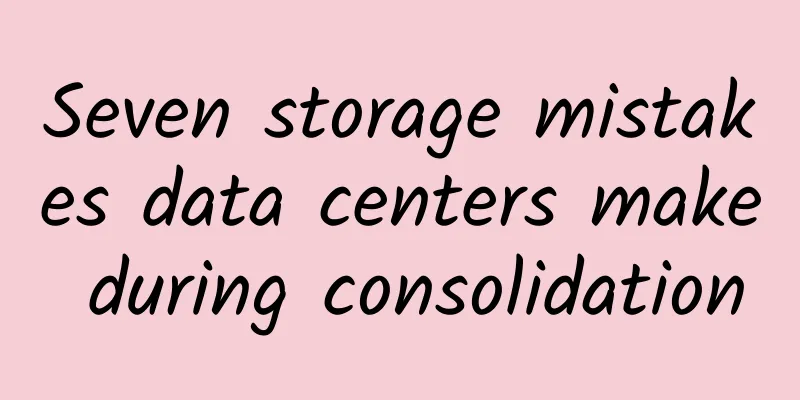Seven storage mistakes data centers make during consolidation

|
Mergers and acquisitions are commonplace in today's business environment. The key to a merger is combining the IT infrastructure of the two companies. The IT department plays a key role in ensuring the success of a merger, but it is also the main reason for merger failures. When companies are eager to complete a merger, IT professionals often make seven common mistakes in storage. Mistake 1 – Rushing into Execution The first mistake is to rush the execution. The first step in this process should be the scope of digital assets that IT can provide to the combined enterprise. This step includes using software solutions to store physical storage systems and the data stored by those systems. An assessment of physical storage systems should include information such as brand, model, type of storage media, and which physical host they are attached to. It should also provide information about the load on each storage system. Load is different from available capacity and involves how busy the system is supporting the attached hosts.
The goal of a physical audit should be for IT teams to develop a strategy for deciding which storage systems need to be retired, which systems can be used for additional workloads, and which ones should be kept as is. For the assessment of the data itself, IT should provide detailed information about the actual data being stored. The enterprise is looking to categorize data based on activity and criticality. In most cases, the majority of data (over 85%) is inactive and can be used for archival storage or migrated to a lower-cost storage tier. Identifying this data at this critical juncture is critical. It shows IT planners which data blocks they need to be concerned about storing and protecting. Mistake 2 – IT doesn’t understand the goals The second mistake is that IT implements the migration without understanding the various processes that the organization runs and the concerns of stakeholders. It is very important to involve IT in discussions with various stakeholders about the system merger to understand their concerns and priorities. The reason IT and stakeholders don't have these discussions is that they are often unproductive because neither party has enough context or a realistic view of future strategy. In order for these discussions to be productive, it's critical to conduct an assessment step before stakeholders get involved. At the end of the assessment, IT should have a basic strategy in place that identifies which applications should be where and which ones should be migrated. IT needs to know exactly what to expect from this move. Essentially, IT wants to use the results of the merger to kick-start the conversation about IT storage options. It should be the starting point for conversations between IT and stakeholders. Again, it is important to have the conversation before any changes are applied. Feedback from these conversations will influence how things are actually executed. Mistake 3: Limiting Choices The third mistake most enterprises make with data center consolidation is limiting their options by trying to consolidate into one data center, or even one storage system within a data center. In the past, the motivation for such consolidation was primarily based on technology limitations, as interconnecting multiple data centers and managing multiple storage systems was expensive and complex. Today's enterprises have higher bandwidth, software-defined networking (SDN), and modern data management software to cost-effectively manage multiple storage systems across multiple data centers. Organizations with multiple data centers generally have several advantages: First, the talent pool of potential employees increases significantly. No matter how well a business is doing, finding talented employees is always a challenge, and moving these employees to a centralized location makes things worse. However, remote offices do not meet such needs. Remote workers need direct access to specific applications and data sets, which in many cases means that companies need to build and operate a localized data center. The second benefit is to bring data closer to the point of creation. Many industries create or collect data in specific areas. For example, on-site shooting in the media and entertainment industry, and on-site services in the energy and exploration industry. If the data center is close to these locations, it can provide value in a timely manner. Finally, these additional data centers can be more redundant because they can back up each other. In the event of a failure in one data center, the others can take over. If IT implements technologies such as SDN and data management, failover and recovery between these data centers can be seamless. The key to a multi-site organization is to determine the role of each location and what data is needed in a specific location to support a specific role. IT teams should not let a multi-site approach lead to data inefficiencies. Even in a multi-site organization there are opportunities to consolidate and optimize data storage. Mistake 4 – Moving large amounts of messy data Data centers in multi-site organizations still need to move data. Enterprises often need to move data to another location for processing or storage, and there is also a lot of data that is deleted from the current storage system. In most data centers, at least 85% of the system data has not been evaluated in a year. Those inactive data should take steps to verify to avoid mistakes such as "rush execution". The question is what to do with all this inactive data. In reality, most of it will probably be deleted. The problem is that there is some data that absolutely cannot be deleted and may have value in the future. Deciding which data to sort out and delete is a difficult task during an organizational merger. In many cases, this data is kept on a lower-cost, more secure storage medium that will save all the data. However, this does not mean that all data should be stored on primary storage. Secondary storage systems are designed specifically to store this type of data, such as Quantum's Lattus object storage, Scalar tape libraries, and cloud services such as Glacier. To reduce costs, they use commodity hardware and high-capacity drives for storage. They also have data resiliency features to ensure that stored data is not affected by storage media failures and data corruption. Data management software solutions are key to realizing the benefits of secondary storage systems, which will automatically move inactive data from primary to secondary storage. These solutions will also provide transparent access to the data's new location so that users can access it as if it had never moved. The combination of storage solutions can be a challenge as organizations require a cohesive strategy from disparate parts. NAS storage systems, data management software and several secondary storage (object, tape and cloud) layers. Fortunately, Quantum Artico appliances powered by StorNext provide front-end NAS data management capabilities and the ability to connect to object, tape or cloud storage for long-term data retention. By using secondary storage systems and data management solutions, IT departments can safely store inactive data, thereby greatly reducing the working set of data and focusing on active data. For example, in a data center with 500TB of data, if the working set of data is reduced to 75TB, it will be easier to manage. Mistake 5 – Missing operational costs The fifth mistake most organizations make during a merger is to assume that the merger will require significant additional IT spending. The implementation of secondary storage systems and data management software should save costs by freeing up capacity on primary storage. For many years, many organizations have not needed to purchase additional primary storage equipment. The implementation of a data management solution should also result in operational cost savings. IT departments spend a certain amount of time every day ensuring that the right data is stored on the right storage, rebalancing storage resources as system capacity is exhausted or moving data for better performance. Data management solutions can automatically resolve these issues, allowing IT departments to address other tasks. Mistake 6 - Endless Upgrades IT departments assume that storage upgrades and system refreshes are the norm, especially during mergers, where the "new system" may actually be a legacy system that the business may no longer need. In the past, migrating data from an old system to a new one was a time-consuming task with a high chance of error. Data had to be copied to the new system, and then configuration files updated to indicate the data's new location. Using a data management solution like Artico, data can be automatically moved to the new system by the data management software. Since the data management solution is the central point where the data is located, there is no need to update any configuration files. Data is automatically moved to the new system without disrupting the user's application. Mistake #7 – Backing Up Everything Another area of consolidation for enterprises is the data protection process. Organizations may spend an inordinate amount of time trying to choose a backup application to protect their data. While this effort is good, the reality is that most organizations need more than one application to get the job done. Some applications are better at protecting certain environments, but few can do a good job of protecting everything. Data protection hardware is an area where consolidation is possible. Data protection hardware is typically distributed across each data protection application. Hardware solutions such as Quantum's DXI data protection appliances enable all of an enterprise's data protection applications to send data directly to a single appliance, consolidating backup storage and improving secondary data storage efficiency. These systems are also WAN efficient and can replicate data to other sites, cross-replicate data between sites, and even replicate data to the cloud. By consolidating backup storage, IT departments can start the process of selecting a single backup solution for the entire enterprise without stress. A centralized storage solution also allows IT departments to easily retain an instance of the legacy backup application if historical access is required. in conclusion The goal of a merger or acquisition is to make the combined business run better. In other words, the goal is 1 + 1 = 3 (or more). IT has the same opportunity to create an IT organization that is more responsive to the needs of the business. First, having to deal with the data assets of both companies can seem like a daunting task. If IT avoids these common merger mistakes by building a strong data management foundation and consolidating backups, it will provide the company with a stronger, more efficient data center after the merger. |
<<: 5 Strategies for Monetizing Mobile Edge Computing (MEC)
>>: Network Experts: 5 best practices for successful IPv6 migration
Recommend
The integrated development of 5G applications is imperative
In the two years since 5G was put into commercial...
Can 5G save operators from negative growth at the beginning of the year?
Although work has not yet been fully resumed, the...
China Mobile Capital leads the investment in Unisplendour Cloud, completes 600 million yuan financing and focuses on the government and enterprise market
On September 15, Unisplendour Cloud Technology Co...
KubeDL joins CNCF Sandbox to accelerate the cloud nativeization of AI industry
On June 23, 2021, the Cloud Native Computing Foun...
5G mobile phones are coming! Who will be the next Nokia?
"With 43 million analog mobile phone users, ...
EtherNetservers: Los Angeles VPS starts at $14.95 per year, 1GB/40GB/1TB, supports Alipay/PayPal
EtherNetservers' special annual VPS has alway...
Current limiting is never an easy task!
[[354146]] This article is reprinted from the WeC...
Black technology! Disruptor! Blockchain, it’s too late if you don’t pay attention to it
In 2008, the concept of blockchain emerged. This ...
Why can TFO reduce TCP to 0 handshakes?
1. Overview In the previous article, why TCP need...
When is the right time to buy Wi-Fi 6E?
Despite the indisputable advantages of operating ...
DigitalVirt: Los Angeles AS9929 line starting at 245 yuan/year, 1GB/20G NVMe/1TB monthly traffic
DigitalVirt recently launched a new promotion, wh...
Sangfor + China Mobile, writing a new chapter of cooperation in the 5G era
From December 6 to 8, the 6th China Mobile Global...
What is Software Development Cloud?
Software Development Cloud Software Development C...
Illustrated TCP three-way handshake: building a network session step by step
In Internet communications, ensuring the reliabil...
Recommend an operation and maintenance tool: a tool for collecting AD domain environment information
Project Introduction ADRecon extracts and consoli...









